Osteochondrosis is a common disease of the intervertebral discs that occurs in people of different ages.Today it is diagnosed in more than 40% of relatively young people under 35 years of age, and in the older category it affects 9 out of 10 people.There are several stages of development and the earlier the pathology is detected, the easier and more effective the treatment is and the lower the risk of dangerous complications.
What is Osteochondrosis?
Intervertebral discs lie between the vertebral bodies and are a type of shock absorber that absorbs stress during walking or other physical activities.Depending on their location, they vary in size: the intervertebral discs are smallest in the neck area and largest in the lumbar area.
They are all built the same.In the center is the nucleus pulposus, which is the main component of the intervertebral disc and has high elasticity.It is surrounded by a fibrous membrane and end plates.
Osteochondrosis is a degenerative-dystrophic disease in which their abrasion leads to a change in the shape and size of the intervertebral discs and creates the conditions for the development of hernias, vertebral body deformities, spondylosis and other diseases.
Thinning of intervertebral discs is a consequence of malnutrition of cartilage tissue, which leads to a gradual decrease in its elasticity and increased fragility.
As a result, the intervertebral discs change their position, their height decreases and micro-tears form on their fibrous membrane.This creates serious conditions for the formation of intervertebral hernias, pinching of spinal roots or blood vessels.
The slightest changes in the condition of the intervertebral discs lead to functional disorders.This is accompanied by pain of varying intensity.At the same time, conditions are created for the development of diseases of internal organs, since the quality of their activity directly depends on the condition of the spine and the conductivity of bioelectric impulses along the nerves.
It can affect one or more discs in any part of the spine.Therefore, osteochondrosis is diagnosed:
- cervical spine;
- thoracic spine;
- Lumbar spine.
In particularly severe cases, the pathological process affects a large part of the intervertebral discs of the spine, which is accompanied by discomfort throughout the back and an almost complete loss of performance.However, osteochondrosis most often affects the lumbar spine, as it bears the greatest load, as well as the intervertebral discs of the cervical spine due to their high mobility.
Development
There are roughly 4 stages in osteochondrosis:
- A decrease in the level of hydration of the intervertebral disc, which leads to its drying out and the formation of microcracks.There are often no signs of the onset of the disease at this stage.
- A decrease in the height of the intervertebral disc, which leads to the appearance of the first pathological symptoms.At this stage, there is a decrease in the distance between individual segments, which leads to a decrease in the tone of the spinal ligaments and the possibility of displacement of the vertebrae from their natural position, i.e.h.the development of spondylolisthesis.In such situations, a wave-like course of the disease is most often observed.A distinction can be made between phases of exacerbation, which are accompanied by acute pain, and phases of remission, in which no discomfort or aching pain occurs at all.
- Deformation of the affected intervertebral disc with the development of a protrusion or prolapse.Sometimes joints are involved in the pathological process, which is manifested by the development of arthrosis or vertebral subluxations.At this stage, the immune system responds to the processes occurring in the spine with the development of aseptic inflammation with swelling of the tissue surrounding the affected spinal-motor segment.Pain occurs regularly, reflex muscle spasms and restrictions in mobility can be observed.In rare cases, there are signs of a neurological deficit (radicular syndrome), which can be traced back to nerve fibers being pinched by the resulting intervertebral disc protrusions.
- Development of complications.Since the human body has extensive compensatory capabilities, the process of osteosynthesis is activated to keep the vertebrae in a stable position when the intervertebral disc loses its functionality.This leads to the formation of bony protrusions - osteophytes - on the edges of the vertebral bodies of the affected spinal motion segment.As a result, two or more vertebrae fuse together and form a single conglomerate, i.e. spondylosis occurs.This always leads to pinched nerves and the development of acute neurological symptoms in the form of paresis, paralysis and serious dysfunction of the corresponding internal organs.
Reasons
Today there are many theories about the origin of osteochondrosis, including vascular, mechanical, hereditary, hormonal, infectious-allergic and others.But none of them is able to fully explain the mechanism of the emergence of changes in the tissue of the intervertebral discs.Therefore, they most likely all complement each other.
A variety of very different factors can lead to the development of osteochondrosis.Among them the most significant are:
- genetic predisposition;
- regular performance of heavy physical work;
- maintaining a sedentary lifestyle;
- the presence of scoliosis or other spinal deformities;
- suffer from back injuries;
- unbalanced diet, vitamin deficiency;
- infectious diseases;
- metabolic disorders;
- congenital anomalies of the spine (Kimerli anomaly, Chiari anomaly, craniovertebral anomalies, sacralization, lumbarization);
- obesity;
- regular severe stress.
It is believed that the greatest influence on the condition of the intervertebral discs is the constant overload of a certain movement segment of the spine.This can involve not only monotonous, heavy physical work, but also constant bending over or the habit of sitting for long periods of time.In such situations, intervertebral discs, muscles and ligaments are put under additional strain and other factors only make the situation worse.
In general, osteochondrosis can be called an almost natural age-related disease, which is an inevitable price of walking upright.
Symptoms
The earliest sign of the development of the disease is the appearance of a crunching sound in that part of the spine where degenerative-dystrophic changes occur.This is a consequence of the appearance of nutritional disorders of the intervertebral disc and the progression of its dehydration.At this stage, patients almost never seek medical help.Therefore, their daily routine, eating habits and other factors remain the same, which contributes to the worsening of the situation and the transition of the disease to the second stage.
As a result, typical symptoms of osteochondrosis appear:
- severe muscle tension in the affected area on only one or both sides of the spine;
- sharp and aching pain that increases with every movement and increases in intensity over time and becomes unbearable;
- numbness in arms or legs;
- Weakness;
- Stiffness of movements, unauthorized restriction of mobility;
- decreased muscle tone up to complete atrophy;
- bad posture;
- Blood pressure increases.
As the pathology progresses, the signs of osteochondrosis worsen.80% of patients experience dull pain in the area of the affected movement segment of the spine, which is also characteristic of myositis.
Osteochondrosis of the cervical spine
When the cervical spine is affected, the pain tends to radiate to the shoulder girdle and arms, and other manifestations of neurological disorders occur.The patient holds the head in the least painful position and turns the entire body if necessary.
In addition, pathologies of organs innervated by the spinal cord region of the cervical spine can develop:
- tinnitus and diseases of the ENT organs;
- Dizziness;
- blurred vision;
- Migraine;
- Irritability and anxiety increase;
- sleep problems;
- increased risk of allergic reactions;
- decreased thyroid hormone levels.
With osteochondrosis of the cervical spine, vertebral artery syndrome and vegetative-vascular dystonia are often additionally diagnosed.
Infection of the cervical spine with osteochondrosis, especially when complicated by bulges and intervertebral hernias, can lead to pinching of blood vessels.This is associated with impaired blood supply to the brain, which can be accompanied by attacks of dizziness, loss of consciousness and even a stroke.
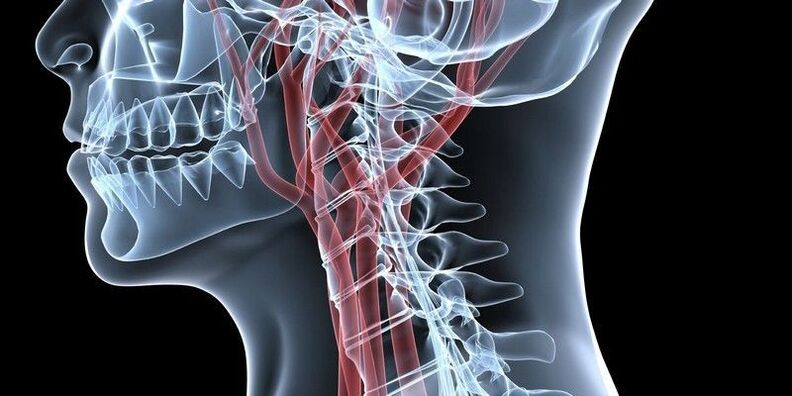
Osteochondrosis of the thoracic spine
In osteochondrosis of the thoracic region, which is rarely diagnosed, pain occurs in the spine at the level of the shoulder blades, which can also increase with deep breaths.They are often felt behind the breastbone, which can be confused with heart disease.
When the spinal roots are pinched, the risk of diseases of internal organs increases, in particular:
- bronchi and lungs (asthma, bronchitis, pneumonia, pleurisy);
- gallbladder and its duct, liver (cholecystitis, jaundice, fat absorption disorders);
- pancreas and duodenum (indigestion, pain in the left hypochondrium);
- adrenal glands, which can affect the overall strength of the immune system and provoke the development of allergies;
- kidneys (urinary tract diseases, chronic pyelonephritis, glomerulonephritis, etc.);
- Pelvic organs (indigestion, gynecological, urological diseases, infertility).
Fact: Damage to the intervertebral disc of the 7th thoracic vertebra due to osteochondrosis can lead to the development of diabetes mellitus.
Osteochondrosis of the lumbosacral spine
In osteochondrosis of the lumbar region, lumbago, called lumbago, is observed.This is accompanied by burning, unbearable pain that occurs suddenly.Often, patients even find it difficult to sit down, stand up and walk, which may indicate the development of radicular syndrome.In such situations, it is easy to observe how they sit down and stand up slowly, trying to avoid tilting their upper body as much as possible.
If complications occur, the main danger is pinching of the nerves of the cauda equina, as this can lead to impaired control over the processes of bowel and bladder emptying, as well as paralysis of the legs.Also in such cases the following may occur:
- Appendicitis;
- diarrhea, constipation;
- pain in the lower abdomen;
- bladder dysfunction;
- Impotence;
- pain in the knees, feet, hips, or groin;
- swelling of the legs.
Complications
Osteochondrosis is a possible cause of a variety of different diseases.If left untreated, bulges and intervertebral hernias will form in most cases.This in turn can cause:
- discogenic myelopathy, leading to paresis, muscle atrophy, changes in tendon reflexes, loss of control over urination and defecation, and even paralysis of the limbs;
- radiculopathy;
- scoliotic or other spinal deformity;
- Spinal cord infarction due to compression of the supplying artery;
- Stroke caused by compression of the occipital artery.
diagnosis
The occurrence of back and neck pain should be a reason to see a neurologist or vertebral doctor.The earlier osteochondrosis is diagnosed, the easier and more effective the treatment is.
To diagnose the disease, the doctor questions and examines the patient.Based on their results, degenerative changes in the intervertebral discs can already be assumed.However, for a final diagnosis, instrumental diagnostic methods are prescribed, including:
- MRI;
- CT;
- X-ray in two projections.
Magnetic resonance imaging provides the most comprehensive information about the condition of the intervertebral discs.The procedure is mainly carried out in closed devices with a capacity of 1.5 T.With its help you can distinguish osteochondrosis from tuberculous spondylitis, osteomyelitis, infectious diseases, etc.
CT scans and X-rays provide information about the bony structures of the spine.Thanks to them, it is possible to detect displacements of the vertebral bodies, the presence of osteophytes and other disorders.
In addition, the following may be prescribed:
- Ultrasound with Dopplerography of the neck vessels;
- electromyography;
- Laboratory research.
Treatment of osteochondrosis
The therapy is developed individually for each patient.In this case, it is necessary to take into account the severity of degenerative-dystrophic processes, the presence of complications, the nature of the patient's work activity and a variety of other factors.
A number of measures must be prescribed to all patients, since pathological changes in the intervertebral discs cannot be eliminated only with the help of medication.Components of conservative therapy for osteochondrosis can include:
- drug therapy;
- osteopathy;
- manual therapy;
- Physiotherapy (phonophoresis, ozone therapy, carboxytherapy, pressotherapy, HF currents);
- Individual sessions with a rehabilitator.
All patients diagnosed with intervertebral disc dystrophy are advised to reconsider their lifestyle.It is imperative, especially for representatives of sedentary professions, to allocate time for moderate physical activity or, conversely, to think about the possibility of changing professions for people who have to lift heavy objects every day.
However, complete rest is recommended in the acute phase.This is ensured not only by observing bed rest, but also by wearing orthopedic bandages: if there is damage to the cervical spine, a Shants collar is used;With osteochondrosis of the lumbar spine, wearing a corset is recommended.
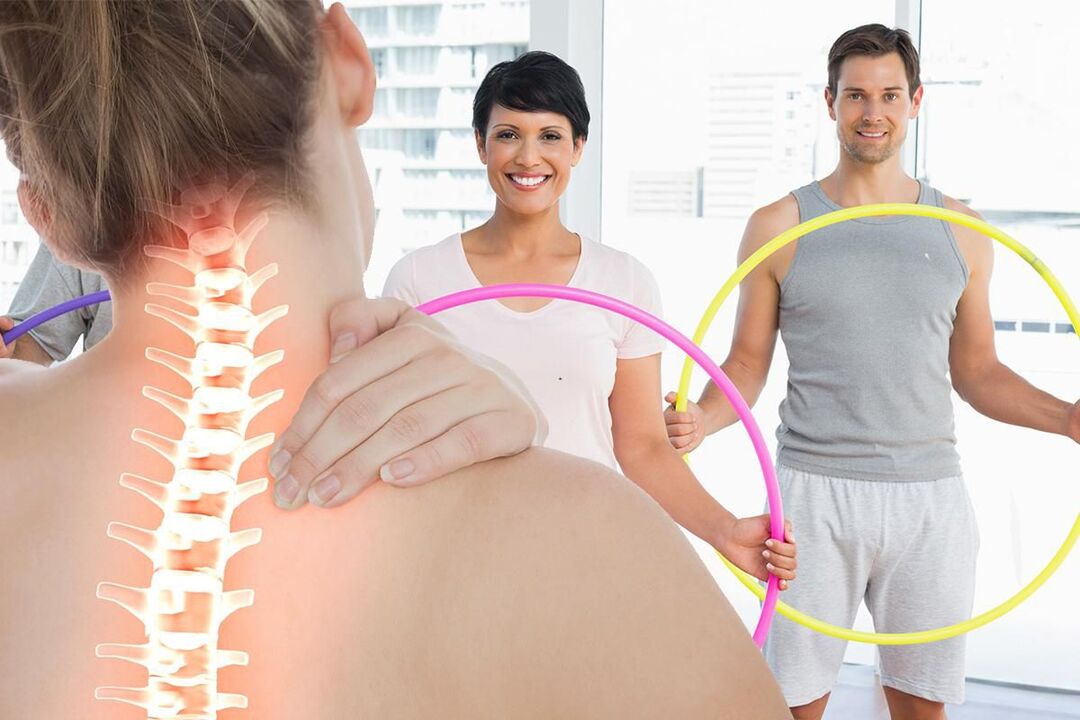
In the first stages of the development of the disease, it is often enough to adjust lifestyle, do exercise therapy and visit a chiropractor.In more advanced cases, drug therapy and physiotherapy are mandatory.
Never resort to self-medication with dubious means, self-prescription of anti-inflammatory drugs, as well as dubious “healers” who position themselves on the Internet: you can lose not only time, money, but also what is left of your health.
Drug therapy
With osteochondrosis, a complex of drugs is prescribed to relieve pain, eliminate inflammation and reflex muscle spasms, improve nerve conduction and activate tissue regeneration processes of the intervertebral discs.
Therefore, patients are prescribed:
- NSAIDs – help relieve pain and have an anti-inflammatory effect;
- Corticosteroids – exhibit strong anti-inflammatory properties;
- muscle relaxants – eliminate muscle spasms, which helps relieve back pain;
- B vitamins – ensure improved function of the nervous system in general and the transmission of nerve impulses along individual nerves in particular;
- Vitamin D is a healing agent responsible for the condition of bone tissue, as well as higher brain functions such as memory, attention and language.
- Chondroprotectors – supply the intervertebral discs with the connections necessary for the construction of new fibers of the nucleus pulposus;
- Psychotropic drugs – increase the effectiveness of non-steroidal anti-inflammatory drugs and muscle relaxants;
- Vascular drugs – improve blood circulation in the tissues surrounding the spine, thereby ensuring a more active supply of nutrients and oxygen to the intervertebral discs;
- Anticonvulsants – used in rare cases to relieve very severe convulsions.
If the pain is very severe, which usually indicates complications, patients can undergo back blocks, which have an immediate effect.Sometimes corticosteroid hormones are added to the solution to carry out the blockade.This also leads to a pronounced anti-inflammatory effect.
Blockades are carried out under conditions of absolute sterility, which can only be achieved in specialized medical facilities.At the same time, they require special knowledge and skills, so only highly qualified health workers can competently cope with the task.Otherwise, there is a high risk of infection or damage to the nerve fiber, which can lead to the development of serious complications.
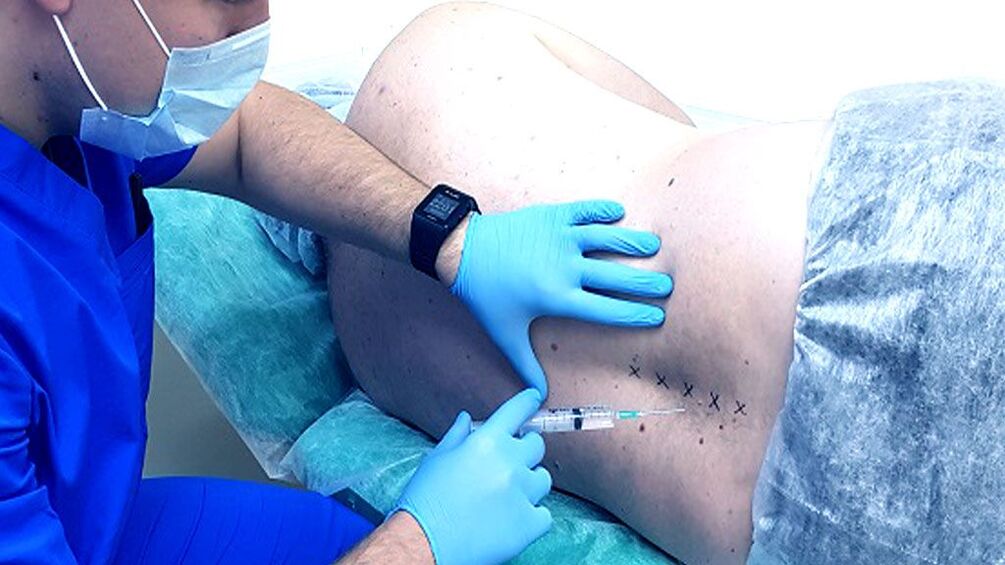
The block usually involves an injection on both sides of the spine in the area where the painful nerves occur.There are several techniques for carrying it out, from which the doctor selects the specific one individually.
However, it is advisable to do blockades no more than four times a year.Since acute, painful attacks of pain occur much more often with osteochondrosis, it is first worth examining the causes of their occurrence, i.e.h.to eliminate the degenerative-dystrophic process in the joint itself.
Manual therapy
Manual therapy sessions are prescribed outside the period of exacerbation of osteochondrosis.They play one of the leading roles in the treatment of the disease, since the competent use of manual techniques on the spine and surrounding tissues helps not only to stop the progression of the pathological process in the intervertebral discs, but also to create the most favorable conditions for their recovery.
In addition, certain techniques can also have a positive effect on the function of internal organs.For example, one of the methods is aimed at eliminating pressure on the spinal roots, blood vessels and spinal membranes by normalizing the position of each vertebra, thereby restoring the normal connection of the organ with the nervous system.This makes it possible to eliminate the hidden causes of the development of the above-mentioned diseases of the heart, bronchi, lungs, kidneys, gastrointestinal tract and reproductive system and leads to complete recovery.
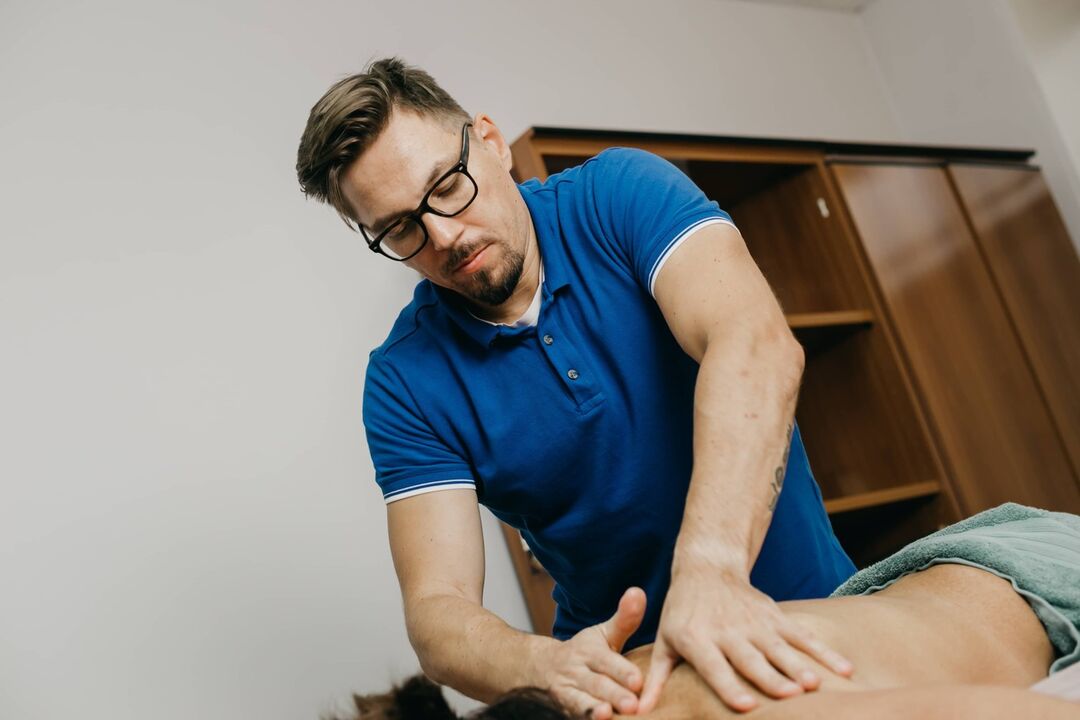
The precise effect on the spine not only activates blood circulation and accelerates the metabolism, like a classic healing massage, but also sets natural self-healing mechanisms in motion.Eliminating spinal curvatures, vertebral misalignments and other pathological changes in the spine through manual therapy can further strengthen the immune system, improve general well-being and significantly improve quality of life.
Positive changes are noticeable after the first session, and in the future their severity only increases.
Physiotherapy
Physiotherapeutic procedures increase the effectiveness of all other methods of treating osteochondrosis and help relieve pain.Most commonly used:
- Electrophoresis – the use of electric current to ensure the penetration of anesthetics, anti-inflammatory and other active substances directly into the site of inflammation, allowing you to quickly achieve a pronounced therapeutic effect;
- Ultrasound therapy – the effect of ultrasound provides an analgesic effect, increases the intensity of metabolic processes in the area of influence and creates the conditions for high-quality restoration of thinned intervertebral discs;
- Detensor therapy – involves stretching and massaging the spine on a special rib mattress, which activates blood circulation and increases muscle tone;
- Traction therapy or spinal traction – is carried out using special devices that create a tensile load on the spine, as a result of which the distance between the vertebrae increases and the pressure on the worn-out intervertebral disc is sharply reduced, allowing for a more active recovery.
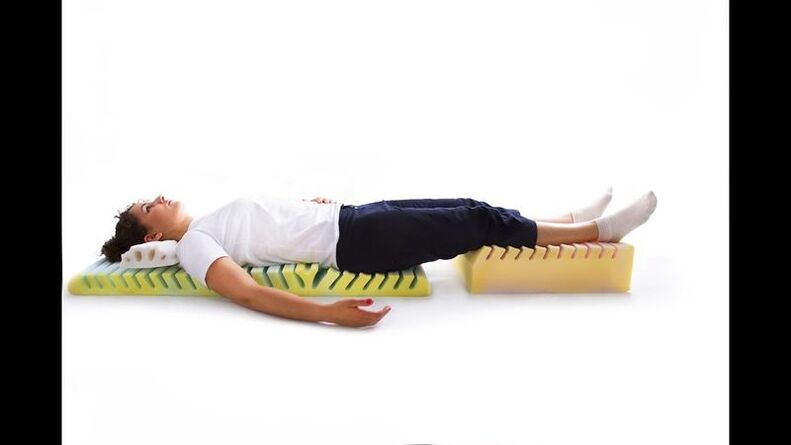
All procedures are prescribed in courses of 10-15 sessions.When choosing, they take into account not only the condition of the intervertebral discs, but also the presence of concomitant diseases, since certain physical effects are contraindicated for some of them.
Movement therapy
Therapeutic exercises for osteochondrosis play an important role, since correctly selected exercises in case of damage to various parts of the spine can help form a strong muscle corset and at the same time eliminate increased muscle tone.This provides good support for the spine and stops the progression of the degenerative process in the intervertebral discs.In addition, exercise therapy helps to activate blood circulation and increase the intensity of metabolic processes.
Creating a physical therapy program is the job of a rehabilitation doctor.Based on the severity of the spinal lesion, the characteristics of the patient's physical development, his age and other factors, he creates an optimal set of exercises, the implementation of which provides optimal loading on the muscles and spine.
The first courses must be carried out under medical supervision.Once the patient has learned to perform each exercise correctly, he or she can continue practicing at home.It is important to avoid sudden movements.All exercises are carried out slowly and evenly every day and the load is gradually increased.However, the appearance of pain during exercise is a good reason to refuse the exercise that caused it.

prevention
It is much easier to prevent the development of an illness than to deal with its consequences later.Since osteochondrosis can occur in everyone sooner or later, you should think about the possible risks as early as possible and do everything in your power to prevent this.Therefore, each person should adhere to the following recommendations:
- Avoid physical inactivity, exercise regularly, swim and take regular breaks to warm up from sedentary activities.
- Pay attention to your posture when walking or sitting;
- buy a high-quality orthopedic mattress and pillow;
- Observe the correct technique for lifting weights: with a straight back and bent knees;
- Swap casual shoes for the most comfortable ones and leave dress shoes for special occasions.
- Eat right so that the body does not suffer from nutrient deficiencies and weight remains within the normal range.
There is only one way to avoid the appearance and manifestation of osteochondrosis symptoms: start taking care of yourself and your health.Since osteochondrosis is not just a disease, but a complex of muscle tonic and neurodystrophic changes, which are the body's response to physical inactivity, chronic static tension of the spinal muscles, the environmental situation and chronic neuroses, which are especially common among city dwellers, swimming in the pool and stretching programs, including yoga.
Thus, osteochondrosis is a very common disease, but if you carefully monitor your own health, you can effectively fight it at any age.However, ignoring the problem will not lead to anything good and will sooner or later force the patient to lie on the operating table.


























